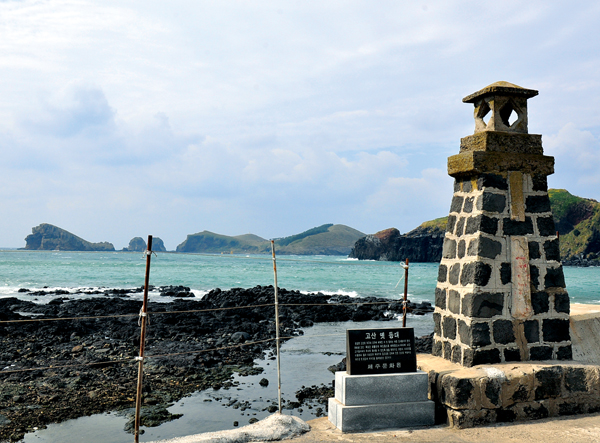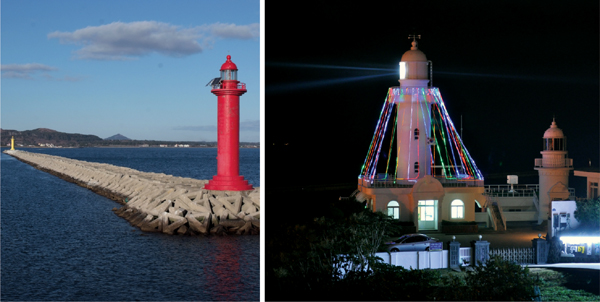
- Updated 2024.4.24 17:16
- All Articles
-
member
icon
-
facebook
cursor
-
twitter
cursor
| |
 |
|
| ▲ Some of Jeju’s early lighthouses remain along the coast. Photos courtesy Jeju City Hall |
A fishing lamp is a flame in the ocean and a must for fishers and sailors. But, before electricity was used aboard ships, working at sea at night was a struggle with darkness. Particularly, night work on a pitch-dark ocean where strong waves and winds surged could be life-threatening. A light visible from a safe port far away was a life-line attached to safety, helping fishers overcome their fear. Early lights marking safe harbor came from lighthouses, and still do, and some old towers still exist on the coast of Jeju. The stone towers seem humble at first glance but were an essential life-preserver for all those who set out to sea.
Before modern lighthouses were introduced to Jeju, traditional towers guided those on the ocean. Known as dodae, dodaet-bul or dodai, in some villages, they were simply called the vigil light or long light. These old lighthouses were used from during the Japanese colonial period through the 1960s and the 1970s before newer electrical models were introduced. The dodaet-bul, lighting the coast of Jeju, were traffic lights in the busy waters and a safeguard for seafarers.
The main material of the old lighthouses was basalt mined from the soil of Jeju. Thus, they were sometimes simply called stone lighthouses. Examples of these can be found can be found at Gosan, Bukcheon and Gimnyeong.
| |
 |
|
| ▲ Modern, electrically illuminated lighthouses have replaced the stone towers that once marked both dangers and safe harbors in Jeju Island’s waters. Photos courtesy Jeju City Hall |
The shapes of lighthouses differ from town to town. Those in Guideok and Daggnae look like stone towers while those in the ports of Gosan, Dumo and Aewol more closely resemble chimneys. Researchers have categorized the shapes as conical, cylindrical, trapezoidal, box and gourd-dipper. The lamps within were fueled by fish or rapeseed oil, kerosene or petroleum. The devices themselves might be simple ceramic dishes burning fuel, kerosene lamps or nampo lamps, a traditional alcohol-fired lamp. The dodaet-bul are part of Jeju’s cultural heritage and illustrate the importance of the ocean for food and trade in the daily life of Jeju residents.
Not many old lighthouses remain in the coastal areas of Jeju. After villages were equipped with electricity, the lighthouses were replaced and many disappeared when ports were renovated and new breakwaters built. There used to be 12 lighthouses in Jeju City, but only eight are left today. Those are located in Gosan in Hankyun-myun, Dumo-ri, Guideok in Hallim-eup, Aewol in Aewol-eup, Guum, Daggnae, Bukcheon, Gimnyeong in Gujwa-eup. Some remain in their original positions but others have been moved to more visible areas as a symbol of the town.
|
|
|
|
|
|
|
|
ⓒ Jeju Weekly 2009 (http://www.jejuweekly.net)
All materials on this site are protected under the Korean Copyright Law and may not be reproduced, distributed, transmitted, displayed, published without the prior consent of Jeju Weekly. |
|
|
|
|
| Jeju-Asia's No.1 for Cruise |
|
|
|
Title:The jeju Weekly(제주위클리) | Mail to editor@jejuweekly.net | Phone: +82-64-724-7776 Fax: +82-64-724-7796
#503, 36-1, Seogwang-ro, Jeju-si, Jeju-do, Korea, 63148
Registration Number: Jeju, Ah01158(제주,아01158) | Date of Registration: November 10,2022 | Publisher&Editor : Hee Tak Ko | Youth policy: Hee Tak Ko
Copyright ⓒ 2009 All materials on this site are protected under the Korean Copyright Law and may not be reproduced, distributed, transmitted, displayed, published
without the prior consent of jeju weekly.com.

|





















